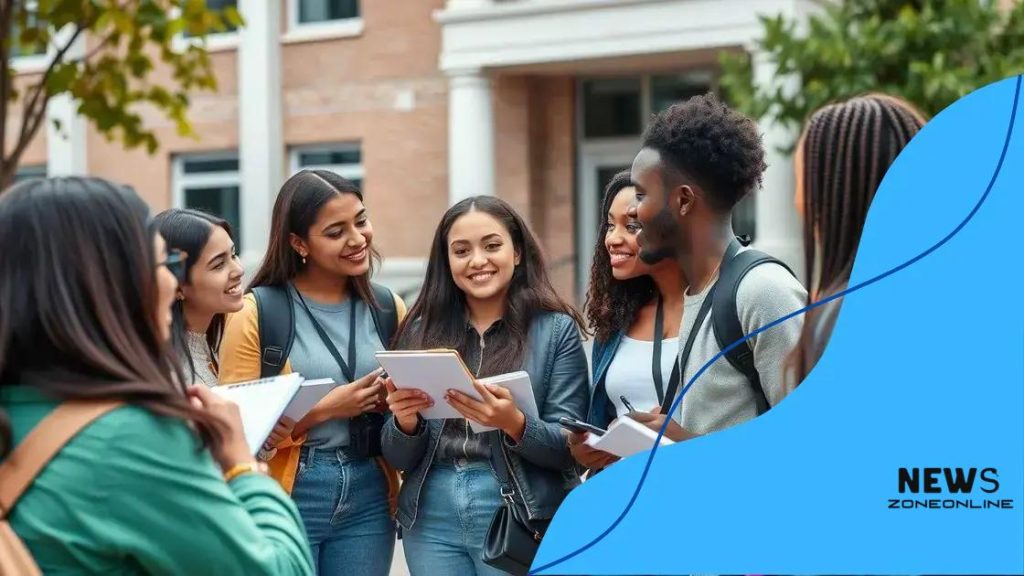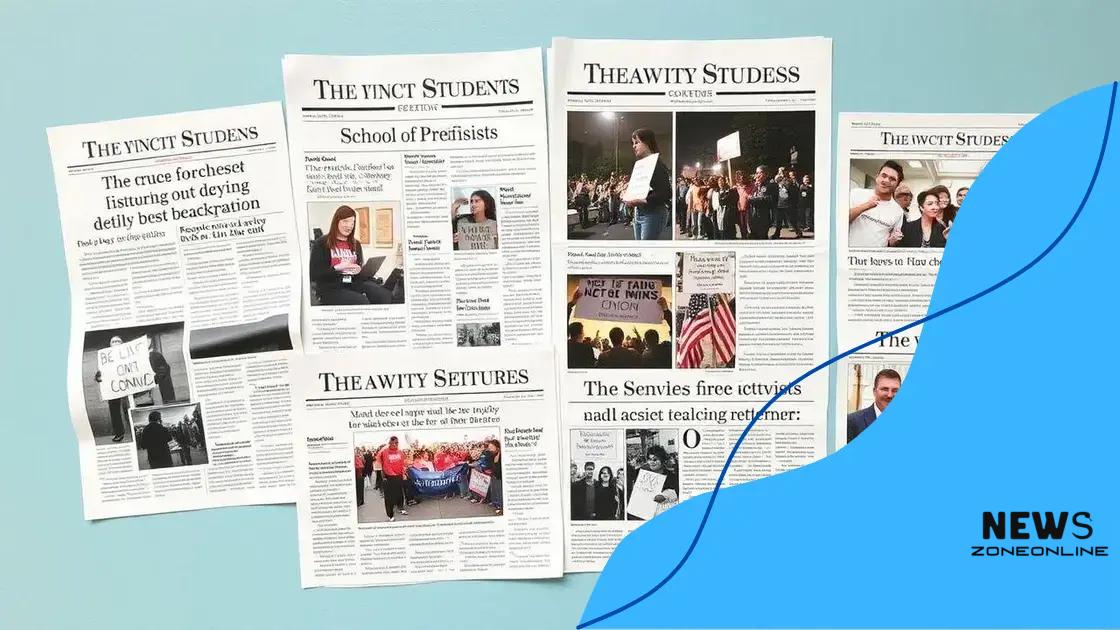Student journalism rights activism: fighting for fairness

Student journalism rights activism empowers students to express themselves freely, advocating for their rights and addressing important issues within their schools through various initiatives and digital platforms.
Student journalism rights activism is crucial for ensuring that young journalists can express themselves and report freely. Have you ever wondered how these rights affect school culture and education?
Understanding student journalism rights
Understanding student journalism rights is essential for fostering a healthy environment for aspiring young reporters. These rights empower students to express themselves and report on important issues within their schools without fear of censorship.
What Are Student Journalism Rights?
Student journalism rights refer to the legal protections that allow students to publish news articles, editorials, and other forms of media on school campuses. These rights are rooted in the First Amendment of the U.S. Constitution, which guarantees freedom of speech and freedom of the press.
The Importance of Free Expression
Free expression in student journalism is vital. It helps students learn to analyze information, develop critical thinking skills, and engage with their communities. When students feel safe to express their views through journalism, they contribute to a more informed and vibrant school culture.
- Encourages critical thinking: Students learn to evaluate sources and form their own opinions.
- Promotes civic engagement: Young journalists often cover local issues, informing their peers and encouraging action.
- Builds leadership skills: By taking charge of school publications, students learn valuable skills that serve them well beyond school.
Despite the importance of these rights, students may still face challenges when attempting to report on sensitive topics. Some school administrations may impose restrictions, fearing negative publicity or controversy. It is crucial for students to understand their rights and to advocate for them.
Legal Framework Supporting Student Journalism
Federal law and various court rulings have paved the way for the protection of student journalism. In the landmark case of Tinker v. Des Moines Independent Community School District, the Supreme Court upheld students’ rights to free expression as long as their actions do not disrupt educational activities.
Guidelines for Students
Students interested in journalism should be aware of some key guidelines:
- Always research and understand your rights before starting any publication.
- Seek advice from teachers or legal experts if you face pushback.
- Engage with fellow student journalists to create a supportive network.
By knowing these student journalism rights, students can better navigate challenges and advocate for their freedom to report. Collective efforts to uphold these rights will ensure that student voices are heard and valued in the educational landscape.
The impact of activism on educational institutions
The impact of activism on educational institutions is profound and multifaceted. Student-led activism can challenge traditional norms and influence policies that affect their rights and experiences. When students unite for a cause, they often bring about significant change in their schools.
Transforming School Policies
Activism has the potential to transform school policies. For instance, when students advocate for freedom of the press, they can lead to the adoption of more supportive guidelines. Schools may reassess their policies to ensure that they uphold students’ rights to express themselves through journalism.
Creating Awareness of Issues
Through activism, students raise awareness of various social issues, such as bullying, discrimination, and mental health. Organizing events, such as awareness campaigns or forums, can shed light on these topics and prompt school administrations to take action. Students can create a wave of change by educating their peers and encouraging dialogue.
- Fostering inclusivity: Activist movements often promote inclusivity and acceptance, creating a safer space for all students.
- Encouraging community involvement: Activism can lead to stronger relationships between schools and their communities, fostering collaboration.
- Developing leadership skills: Students learn valuable skills in organizing, public speaking, and advocacy through activism.
Moreover, activism often brings students together, fostering a sense of solidarity. When they unite for a common cause, they build connections that can last a lifetime. This fellowship can empower students to continue advocating for their rights and the rights of others.
Resistance and Challenges
While activism can lead to positive outcomes, students may also face resistance. Some school administrations may be hesitant to change established policies or may view activism as disruptive. It is important for students to remain persistent and seek constructive ways to engage with school leaders.
Ultimately, the impact of activism on educational institutions is largely positive. Whether it’s advocating for better reporting rights or addressing social issues, students play a crucial role in shaping their educational experiences. By standing up for their rights, they not only benefit themselves but also pave the way for future generations of student journalists.
Prominent cases of student journalism activism

Prominent cases of student journalism activism showcase how young voices can lead to meaningful change. These instances highlight the courage and creativity students display when standing up for their rights.
Case Study: The Parker High School Journalism Program
At Parker High School, students rallied to defend their right to publish an article about school policies. When the administration attempted to censor their work, students organized a protest. Their activism led to an open dialogue with school officials, ultimately resulting in a revised policy that supported student publications.
Case Study: The Student Newspaper at East High
Students at East High School uncovered serious issues regarding mental health resources inadequacy on campus. Their article not only caught the attention of peers but also prompted local news outlets to investigate further. The fallout led to improved resources for mental health support, showing how journalism can instigate real change.
- Empowering students: These cases demonstrate how student activism empowers individuals to voice their concerns.
- Creating community awareness: Journalism can inform the broader community about issues affecting students.
- Fostering resilience: Students learn to face challenges and advocate for their needs through these experiences.
The efforts of student journalists have often resulted in policy changes that benefit not only current students but also future generations. Additionally, their tenacity encourages other schools to consider the value of student journalism and its impact on education.
Case Study: The Anti-Bullying Campaign
In a notable example from a Georgia high school, student journalists produced a series of articles focusing on bullying. They invited their classmates to share personal stories, which opened up discussions about mental health and support within the school. This reporting led to the establishment of a peer support program, helping students address bullying effectively.
These prominent cases illustrate that the activism embedded within student journalism is not just about reporting facts; it is often about driving essential societal changes. The power of student voices cannot be underestimated, and their efforts continue to ripple through school systems nationwide, reinforcing the importance of student journalism rights.
How students can advocate for their rights
Students can play a vital role in advocating for their rights through various means. By becoming informed and engaged, they not only enhance their own educational experiences but also contribute to positive changes within their schools.
Understanding Your Rights
The first step in advocacy is to understand what rights students have. Students have the right to express themselves freely, access information, and participate in school governance. Familiarizing themselves with these rights helps students speak up effectively when needed.
Organizing and Mobilizing
Students can organize events to raise awareness about their rights. Whether it’s a peaceful protest, an informational meeting, or a social media campaign, mobilizing their peers creates a powerful voice. By working together, students demonstrate solidarity and amplify their concerns.
- Create a student council: Representing student interests can help address specific issues.
- Host workshops: Educating peers about their rights fosters a more aware student body.
- Use social media: Platforms like Instagram and Twitter can help spread awareness quickly and effectively.
Moreover, writing articles for the school newspaper provides a platform to discuss important issues. When students highlight their experiences and share their stories, they generate interest and support from the wider school community.
Engaging with Administrators
It’s important for students to engage directly with school administrators. This could be through scheduled meetings or open forums. When students present their concerns respectfully, they create opportunities for constructive dialogue.
Additionally, students should seek allies among teachers and staff. Building positive relationships with faculty can lead to greater support for their advocacy efforts. Faculty members can act as mentors, offering advice and guidance on how to effectively voice their concerns.
Utilizing Existing Resources
Students can also utilize existing resources such as non-profit organizations or legal aid groups that focus on educational rights. These organizations often have tools, templates, or guides that help students navigate their advocacy efforts.
By engaging in these practices, students empower themselves and their peers. Advocacy not only benefits students individually but also helps cultivate an atmosphere of respect and support within educational institutions, reinforcing the importance of student journalism rights and their role in shaping school policies.
The future of student journalism
The future of student journalism is bright and full of potential. As technology continues to evolve, so do the opportunities for student journalists to engage their peers and the community. Understanding these trends can help prepare students for the changing landscape of media.
Embracing Digital Platforms
Digital platforms are becoming increasingly important in student journalism. Students now have access to blogs, podcasts, and social media, which allow them to share their stories widely. This expands their audience beyond the school and connects them with experts and communities around the world. Adapting to digital trends is crucial for student journalists.
Focus on Multimedia Storytelling
In the future, student journalism will likely emphasize multimedia storytelling. This involves using combinations of video, audio, and written content to create engaging stories. By learning to produce videos or podcasts, students can reach their audience in diverse ways. Multimedia content often resonates better with young audiences who consume information differently than in the past.
- Workshops and training: Schools can hold workshops that teach students how to create multimedia content.
- Leveraging social media: Students can use platforms like TikTok and Instagram to share quick, impactful stories.
- Engaging with the community: Collaborating with local organizations can help students produce more relevant content.
Additionally, as social justice issues gain more attention, student journalism will likely become more focused on advocacy. Students are passionate about issues like mental health, environmental concerns, and social equality. By using their platforms to amplify these voices, they can make a difference.
Building a Supportive Network
The future of student journalism will also benefit from building supportive networks among young journalists. Connecting with professional journalists and other organizations can provide mentorship opportunities. These relationships can help students refine their skills and navigate the challenges they face.
Moreover, creating strong networks helps student journalists navigate potential challenges, such as censorship or administration pushback. Schools should encourage dialogue between students and staff, fostering an environment where voices are heard and respected. The growth of student journalism not only enriches the school community but also prepares students to be informed citizens.
FAQ – Frequently Asked Questions about Student Journalism Rights
What are student journalism rights?
Student journalism rights refer to the legal rights that allow students to express themselves freely and report on issues without censorship in schools.
How can students advocate for their journalism rights?
Students can advocate by organizing events, engaging with school administrations, and using digital platforms to raise awareness about their rights.
Why is student journalism important?
It promotes critical thinking, encourages civic engagement, and helps students develop important skills for their future careers.
What role does technology play in student journalism?
Technology enables students to use various digital platforms for storytelling, enhancing their reach and impact within their communities.





